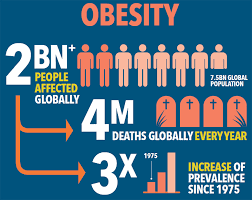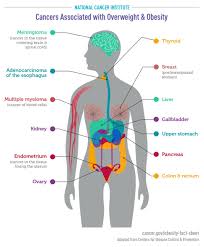Latest viral Obesity and Related Diseases: A Growing World and Global Health

Obesity has become one of the most significant health challenges of modern times. It is defined as excessive fat accumulation that poses a risk to overall health, often measured by the Body Mass Index (BMI). A BMI of 30 or higher is classified as obesity. According to the World Health Organization (WHO), global obesity rates have nearly tripled since 1975, with over 650 million adults categorized as obese in 2022. This crisis is no longer limited to wealthier nations; developing countries are also witnessing alarming spikes in obesity rates.
More than just a weight issue, obesity is linked to several chronic diseases, including diabetes, heart disease, and even certain types of cancer. This article delves into the causes, health risks, and possible solutions to this growing epidemic.
Causes of Obesity

Obesity is not just about eating too much or exercising too little. It is influenced by a combination of genetic, lifestyle, environmental, and psychological factors.
Unhealthy Eating Habits: Overconsumption of high-calorie, processed foods, sugary beverages, and fast food has contributed significantly to rising obesity rates. These foods are often more affordable and widely available than nutritious options.
Lack of Physical Activity: Sedentary lifestyles, increased screen time, and decreased physical activity mean fewer calories burned. The WHO estimates that one in four adults does not get enough exercise.
Genetic Factors: Genetics can influence appetite, metabolism, and fat storage. Research suggests that hereditary factors account for 40–70% of an individual’s obesity risk.
Socioeconomic and Environmental Factors: Food deserts (areas with limited access to fresh, healthy food), aggressive marketing of unhealthy products, and high-stress environments contribute to weight gain. Low-income groups often struggle with obesity due to limited access to healthy food and fitness resources.
Psychological Aspects: Stress, lack of sleep, and emotional eating can lead to overconsumption of calorie-dense foods, further increasing obesity risk.

Understanding these causes is crucial for creating effective strategies to tackle obesity.
The Link Between Obesity and Metabolic Syndrome
The Link Between Obesity and Metabolic Syndrome
Obesity significantly increases the risk of metabolic syndrome, a cluster of conditions that raise the likelihood of heart disease, stroke, and type 2 diabetes.
Abdominal Fat: Excess fat around the abdomen disrupts hormonal balance and increases inflammation.
Insulin Resistance: Obesity interferes with the body’s ability to process sugar efficiently, often leading to diabetes.
High Blood Pressure: Extra weight puts strain on the heart, increasing blood pressure levels.
Unhealthy Cholesterol Levels: Obesity is often associated with high triglycerides and low HDL (“good cholesterol”), which contribute to heart disease.

How Obesity Increases Cardiovascular Disease Risk
Obesity is one of the primary contributors to cardiovascular diseases (CVDs), which are the leading cause of death worldwide. Several mechanisms link obesity to heart disease:
Atherosclerosis: Excess fat deposits in arteries narrow blood vessels, increasing the risk of heart attacks and strokes. Obesity and Related Diseases: A Growing World
Heart Overload: The heart must work harder to pump blood in an overweight body, which can lead to heart failure over time.
Irregular Heart Rhythms: Sleep apnea, common in obese individuals, can lead to irregular heartbeats and other complications.

The Connection Between Obesity and Type 2 Diabetes
Type 2 diabetes is one of the most common chronic conditions linked to obesity. Nearly 80% of individuals diagnosed with type 2 diabetes are overweight or obese. The excess fat, particularly around the liver and pancreas, leads to:
Insulin Resistance: Inflammatory substances released by fat cells disrupt insulin function.
Pancreatic Stress: The pancreas overproduces insulin to compensate, eventually leading to beta-cell dysfunction.
Lifestyle changes such as regular physical activity, a balanced diet, and weight loss can significantly reduce diabetes risk.
Obesity and Cancer: An Overlooked Threat
Recent research has shown that obesity is linked to at least 13 types of cancer, including breast, colorectal, and liver cancer. The underlying mechanisms include:
Chronic Inflammation: Excess fat promotes inflammation, which can damage cells and lead to tumor formation.Obesity and Related Diseases: A Growing World
Hormonal Changes: Higher levels of insulin and estrogen in obese individuals create a favorable environment for cancer growth.
Gut Microbiome Disruption: Obesity alters gut bacteria, potentially increasing carcinogen production.

Prevention and Treatment Strategies
Addressing obesity requires a multi-pronged approach that includes lifestyle changes, community efforts, and policy interventions.
Prevention Measures
Healthier Diet Choices: Consuming more whole foods, lean proteins, and fiber-rich meals while cutting back on processed foods can help maintain a healthy weight.
Regular Exercise: Engaging in at least 150 minutes of moderate exercise per week (e.g., walking, jogging, swimming) can significantly aid weight management.
Better Sleep and Stress Control: Managing stress and ensuring quality sleep (7–9 hours per night) can help regulate appetite and metabolism. Obesity and Related Diseases: A Growing World
Government Policies: Sugary beverage taxes, better urban planning for active lifestyles, and promoting nutrition education can encourage healthier choices at a broader level.
Treatment Options
Lifestyle Interventions: Guided weight management programs combining diet, exercise, and behavioral therapy are effective first steps. Obesity and Related Diseases: A Growing World
Medications: Prescription drugs like semaglutide (Wegovy) or liraglutide (Saxenda) can help suppress appetite and boost weight loss.
Bariatric Surgery: In cases of severe obesity, procedures like gastric bypass or sleeve gastrectomy can lead to significant weight loss and improved metabolic health.
Conclusion: A Call to Action
Obesity is not just about appearance—it is a serious medical condition that affects millions worldwide. Beyond individual responsibility, systemic changes are necessary, including better access to healthy food, promotion of physical activity, and tackling weight stigma. Through awareness, early intervention, and compassionate healthcare, we can slow down this epidemic and create a healthier future for the next generations. Obesity and Related Diseases: A Growing World
[…] obesity and Related Diseases A Growing World […]